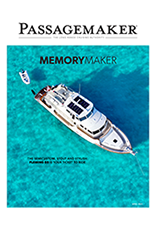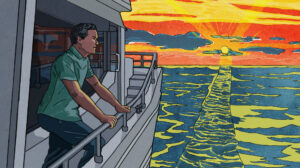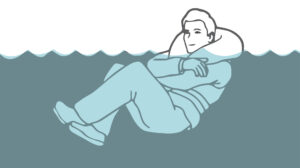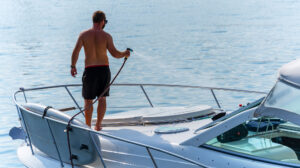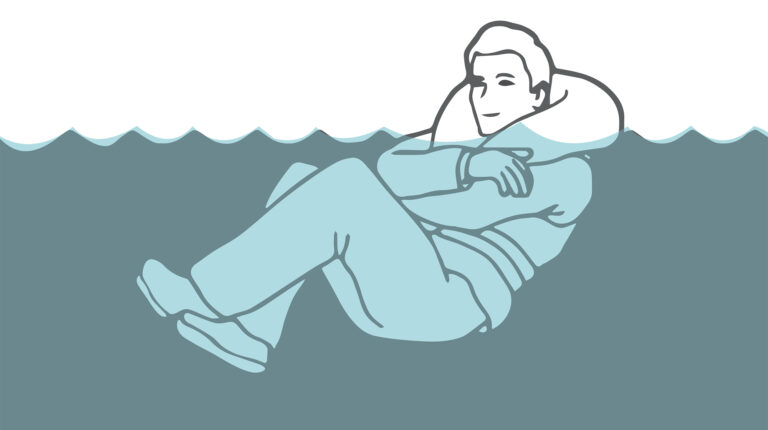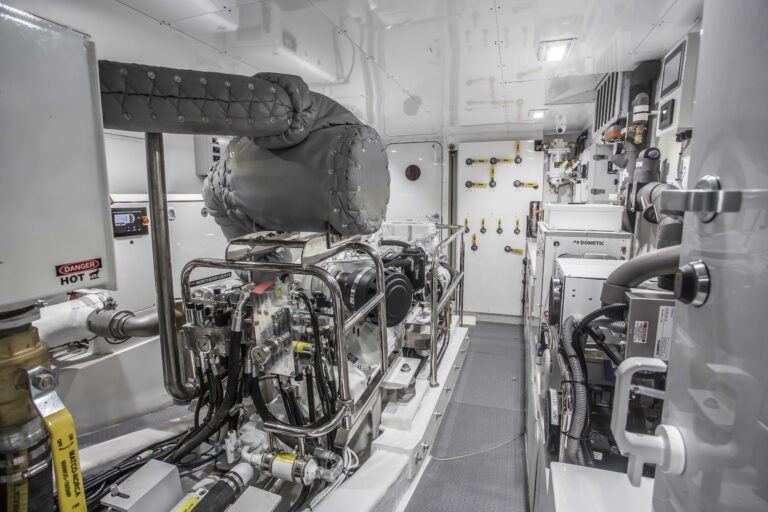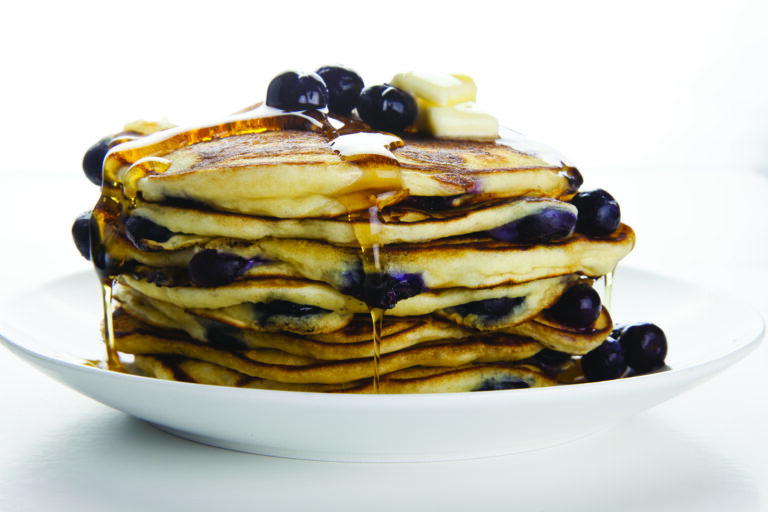Boat Charter: The Ultimate Vacation
Whether you do it yourself or hire a professional crew to reduce an element of responsibility, chartering lets you hone your boating skills like nothing else, and in many cases, to “audition” various types of boats on the way to owning one.
The most common type of charter is the bareboat charter. You work with a charter company to reserve a boat that you’ll provision and command on your own. It’s called bareboat because you will be the captain creating the itinerary, running, anchoring and caring for the boat yourself. Some level of experience is required.
If you’d rather leave the driving and the details to someone else, or would like instruction during your vacation, a crewed charter is your best option. On yachts under 60 feet, your “crew” consists of either a captain only or a captain and a chef. Provisioning may be done for you, and it will be added to the bill.

The captain runs the boat and usually takes you to the most popular the cruising grounds and has local knowledge of what to see, where to eat and where to cruise. The captain is also the responsible party in case anything breaks or goes wrong, so your vacation is more about relaxing rather than working.
The downside of crewed charter is that your captain remains on your vessel with you and therefore is a part of your group at all times. A professional captain also adds to the cost and is usually tipped at the end of the charter for good service.
THE EXPERIENCE

The boaters come, Shane Ellis says, from as far away as California, Florida and Europe. And they’re all seeking the same thing: a chance to put their boating skills to use along the coast of Maine.
“I don’t get very many novice boaters,” Ellis says. “For the most part, they’re people who own boats and either don’t want to bring them up this far, or they just sold their boat and want to get on the water for a week or two.”
Ellis runs Ellis Boat Charters out of Maine’s Southwest Harbor, long known for its scenic beauty, strong boatbuilding heritage and classic Downeast designs. His charter fleet includes five Ellis 36 boats, a Hinckley T40 and a Hinckley 38, all of which are available for charters of a few days or longer, with or without a captain.
“I have people who have been coming here for five years now,” Ellis says. “Many will hire a captain for two days. Maybe they own smaller boats in other places, and the bigger-boat experience is a little scary for them. It’s different than their 20-foot Whaler. After two days with a captain, things aren’t so scary.”
Ellis Yacht Charters is just one of numerous companies that offer boaters the chance to bareboat, or cruise with a captain, in parts of the United States where they either don’t want to bring their own boat or want to try a new style of cruising. While many people think chartering a boat is for landlubbers who don’t own vessels of their own, these companies say they regularly book full weeks on board with boat owners simply looking for a change. CLICK HERE to read the full story.
Pushing Boundaries

About a thousand nautical miles up the Inside Passage and beyond, into Alaska’s waters, is a place that countless boaters dream of cruising. The region is teeming with whales, glaciers and scenery that towers high above the anchorages in majestic grandeur, but also presents the challenges of routine fog, 20-foot tidal swings, and distances between ports that are so long and remote, even the most experienced skippers can feel hesitant to leave the dock.
Those challenges are why so many boaters from around the United States and beyond are booking bareboats as part of captain-led flotillas, says Brian Pemberton, the former-owner-turned-spokesman for Washington-based NW Explorations. The majority of the company’s bareboat clients who book Grand Banks, Ocean Alexander, Kadey-Krogen and similar boats, he says, are already boat owners themselves. Some have spent lifetimes on the water, aboard everything from lake-cruising boats to offshore trawler yachts.
In booking a bareboat to a place like Alaska, he says, those boaters are trying to push their own cruising boundaries, whether geographically, with a larger or different style of boat, or with a longer liveaboard stay than they’ve done in the past. Having a lead boat in a flotilla with a locally savvy skipper at the helm, not to mention a tech-savvy crew and naturalist at the ready if needed, gives those bareboaters the confidence to cruise in places they simply don’t want to try and go alone. CLICK HERE to read the full story.
Why Get a Captain?
Having a captain aboard seems like the antithesis of bareboat chartering, but in many cases it’s actually the cherry on top of a wonderful nautical sundae.
Experienced boaters may opt to have a captain for several reasons. The charter company may not be entirely comfortable with your boating experience, you may need help if you’re short-handed as a couple, or you may not know the geographical area.
But there are a host of other good reasons for having a captain aboard. For one, many charter companies offer a combination of bareboat charter and classroom taught by a captain/instructor. This lets boaters get an International Certificate of Competence, which is needed to bareboat in many popular destinations.
Having a captain also can eliminate the cost of a hull damage waiver, which can run to several hundred dollars a day when bareboating. With a captain, the guests have no such liability.
In almost every case, the captain is either an employee of the charter company or a trusted subcontractor. (Don’t worry about ending up with Capt. Ron.) The captain can do the heavy work, such as raising anchor and hoisting sail, and he’ll handle the boat when guests want to relax. Docking is where captains almost always take over. But, most captains enjoy teaching, and just watching a captain can be instructive.
What a captain doesn’t do is act as a babysitter. If the kids need a nanny, bring one. The captain is also not a cook, but those can be hired too.
The captain gets his own stateroom, which, on many bareboats, means giving up one stateroom that would otherwise be for guests. On a growing number of powercats, sleeping quarters and a head for the captain are in the forepeak of each hull, with separate access from the deck.
Bareboat clients are responsible for feeding the captain, so build that expense into the provisioning list and budget. When guests go ashore to dine, the captain doesn’t expect to join the fun, so leave food aboard.
Some charter companies have captains aboard during the day who head home once the boat is securely moored or anchored. Other companies will provide a skipper for the first few hours of a charter, for one-on-one instruction.
If anything breaks while on charter, the skipper will either fix it or coordinate with the charter base to solve the problem. Bareboat charter companies can arrange a captain for around $150 to $200 per day.
And best of all, most charter skippers are people lovers, and fun to be around.

DESTINATIONS
Covid-19 halted much of the travel industry this year, but the situation is showing signs of improvement. As countries begin to recover from the coronavirus pandemic, small pockets are slowly starting to open their doors to travelers, with a lifting of restrictions on many airports, marinas and waterways. But what does this mean for your charter vacation?
The Bahamas, for example, has a workable plan for welcoming boaters during the Covid-19 pandemic, implementing strict protocols to open its doors to boaters willing to abide by the new safety regulations.

LeAnn Morris Pliske, stuck at home in Fort Lauderdale with her husband, their 12- and 13-year-old kids, and a couple of dogs, was the personification of pretty much every American’s psyche this past summer. “I was losing my mind,” she says. “My kids were stir-crazy. We had to get out of here.”
They all got tests showing they were negative for Covid-19, packed up that paperwork along with their passports, the Bahamas health visas that they obtained online, and their usual customs forms, and headed to the islands aboard their 45-foot Hatteras sportfisherman Half Fast. A few hours and 50 nautical miles later, they were legally off the coast of Bimini with three weeks’ worth of supplies, and with aquamarine water and open space all around them. CLICK HERE to to read the full story.
Get Lost in the Caribbean…
With so many alluring ports of call at your disposal, an extended West Indian charter itinerary can seem intimidating. The relatively close proximity of the islands that comprise the Windward and Leeward island chains of the Caribbean makes the region well situated for island-hopping. For example, you can go from snorkeling off Anguilla one day to enjoying French cuisine on St. Barts the next.
We asked dozens of experienced cruisers about their favorite Caribbean destinations. From iconic, paradisiacal backdrops to far-flung secret anchorages, here’s the Passagemaker-approved Caribbean wanderlist. CLICK HERE.
BOATS

There is no right or wrong answer in choosing between a monohull and a catamaran for charter. Different types of boats lend themselves to different types of charters.
The centuries-old dispute over which is more preferable—one or two hulls—boils down to several factors, each with distinct advantages and disadvantages. While the final verdict is usually founded on personal preference and intended use of the vessel, that didn’t stop these two experts on the subject from stepping into the ring for some friendly sparring on the matter.

Though powercats continue to gain traction in the charter-boat market offering owners more space, greater privacy and better fuel efficiency and seakeeping ability than monohulls of similar length. Here is a sample of some of the best cats (and tris) on the market today.
But it’s not all about catamarans…
TRY BEFORE YOU BUY

Ford and Janice Griswold were out on Puget Sound in Washington state, relaxing aboard a friend’s Polycraft 60. It was July Fourth a half-dozen years ago, and the experience was magical: great weather, comfortable cruising, boats of all kinds everywhere they looked.
“We looked at each other like, ‘Oh my God, this is so cool. We have to figure out a way to do this,’” Ford recalls.
They started shopping boat shows. Janice had grown up on the water, cruising as a child aboard her parents’ Uniflite 36, while Ford’s grandfather had been a commodore of the New York Yacht Club, giving Ford the chance to hang out as a kid with the crew of the America’s Cup yacht Courageous. The couple, as adults, felt like they could hold their own while shopping the docks. They just had to learn all the new lingo and systems.
“If we had bought a boat day one, we would’ve bought a boat with Volvo Penta IPS drives,” Ford says. “We figured it was the wave of the future: It’s easy-peasy with the joystick. It slides right into the slip.”
Then, they did some actual cruising and realized they wanted an entirely different type of boat. They booked a few charters with NW Explorations, a Bellingham-based company they’d seen at boat shows offering a fleet with the brand names Sabre, Grand Banks, Defever, Kadey-Krogen and Grand Banks. After chartering on those boats a few times, they thought they would buy a Grand Banks Europa. They liked the semi-displacement hull and the ability to cruise at 18 or 20 knots.
Until they did a flotilla charter with NW Explorations, spending more than just a few days aboard.

“We changed our minds,” Janice says. “Being on board for two weeks, for me, I wanted a different sleeping arrangement from the forward master. NW Explorations suggested we take a look at a classic with a full master stateroom in the back.”
Today, they are the happy owners of a boat that wasn’t even on their initial list—a 2001 Grand Banks 46 Classic—and have joined the ranks of countless owners who started out as charter clients and used the vacation process as a shopping tool. CLICK HERE to read the full story.
MONEY MATTERS
Charters are priced in various ways that let you do as little or as much of the actual boating work as you please. There are bareboats, which means you are your own captain, chef and crew, and your charter rate generally only covers the use of the boat. A flotilla charter usually means you’re paying for the boat plus access to a fleet-leading skipper and maybe a nature guide shared among the boats in the group. A captain-only charter means you get the boat and your own liveaboard skipper, while a crewed charter means you’re a guest and there’s a crew living aboard to do everything, including cooking your meals.
Pay attention to the fine print: Crewed charters can be marketed as base rate only (just the boat and crew, with food and drinks being charged as extras) or inclusive (meaning the advertised rate covers the boat, crew, meals, ship’s bar and most other expenses).

